Notes for if I get invited to deliver an important talk:
Everything is connected. This is both an ancient and popular concept—or perhaps truth. But what does it really mean?
Most mornings, as I’m finishing my Five Tibetan Rites, I drop my forehead down to my yoga mat and say: “I am one with everything.” Sometimes it feels like I’m reminding myself of a truth I tend to forget. Other times it’s more like I’m trying to convince myself. Because even if intellectually I understand when Neil deGrasse Tyson says everything is made from the same stardust, and spiritually I resonate with the Buddhist assertion that every rock or flower is plugged into the same universal energy of existence that I and my downstairs neighbor’s chinchilla are, still I have a hard time feeling it. I have a hard time feeling elemental kinship with everything.
My yoga mat, for example, is made from some foamy, nubbly material, fabricated by some highly machinated process in some factory lab in some corner of the earth that will forever be unknown to me. I’m not sure if I even care to be one with a mat. I might rather recognize our differences. That might make me feel better than oneness would. By contrast I am clearly more alive. In general, I don’t get much of a communion-y vibe off of plastics. But perhaps these are the seeds of prejudices and -isms. I must be careful not to become a materialist.
On the subject of my downstairs neighbor’s chinchilla: did you know that chinchillas bathe in dust? She has a little plastic house, my downstairs neighbor—let’s call her Athena—filled with this very fine greyish dust, into which the chinchilla regularly retreats for baths. The house is transparent, so you can see the chinchilla inside as it spins spastically in the dust. It’s how they keep their coats clean and lustrous, supposedly. So I wonder: if you have, say, a chinchilla stole, does that mean that it is every moment losing luster that can never be restored?
For perhaps obvious reasons, Athena was not interested in pursuing this speculation with me, which is why I am bringing it before us here today. Surely a group of people as curious and intelligent as us should be able to locate meaning in humankind’s inability to hold onto the shine of life it stole from the chinchillas for a stole—which does what exactly?
Thoughts on Athena herself:
– Despite never accepting invitations for a drink on the roof, she seems to be warming to the possibility.
– The other day I held open the front door for her. I wish I had done it more smoothly, but she was thankful. I had the recycling in one hand, the trash in the other. Unfortunately, trash was dripping trash juice.
– I’ve offered to chinchilla-sit, should she ever need to go away for a few days, told her that really it’d be no trouble at all, but she didn’t exactly jump at the offer. Afraid I gave her the wrong impression when I brought up chinchilla fur as separate from chinchilla.
Slide #1:

Earlier I said that “intellectually I understand when Neil deGrasse Tyson says everything is made from the same stardust,” but that’s not actually true. I thought it was true when I first wrote it, but looking at this slide for awhile just made me realize that I do not understand it at all. Of course, all of us here know that it goes back to the Big Bang Theory, and we have a sense of what the Big Bang was, but let’s stop to actually think about the Big Bang for a minute. Supposedly, before the universe was the universe as we now know (and don’t know) it, before the Bang, it was a tiny, fiery nugget. A “singularity” they call it. The singularity. The only, single thing. Then it exploded and became everything. All of the matter that is—every chinchilla, every yoga mat, every one of you, me, Athena—all of it is said to be composed entirely of stuff that was already contained in that one super intense nugget.
How on earth are we to comprehend that density?
Let us consider hair. Hair-science.com tells me that human hair is made mostly of keratin, a protein formed from 18 amino acids, which if I remember correctly, are some of the basic units of matter and life on earth, along with, I want to say, nucleotides and peptides. Biology flash cards that haven’t crossed my mind in 15 years are flashing again now. There are also lipids involved—fats, which are what make the hair shine. Here we are, talking about shine again. Athena’s hair, for example, must have a particularly healthy balance of acids and lipids, because it seems to hold light, while also subtly reflecting it—like clean, clear water can do at certain times of day, glowing from within when you look into it from one angle, reflecting the sky when you look from another. I can’t even tell you that Athena’s hair is this color or that color, because it changes with light, changes with her skin and her clothes. When I see her after she’s just biked home from work, glistening and flushed, in her red peacoat, I swear her hair is more red. And on the day that her first chinchilla died—I didn’t tell you, this current one is her second—and I saw her teary in the stairwell and asked if she was okay, I swear that day her hair was darker.
But the point, at least as I’m seeing it now, is that Athena’s hair and my hair are of the same origin, which does make me feel connected to her, while at the same time reminding me that I am no more inherently connected to her than any other cluster of molecules that happens to be doinking around in the universe, all of us constantly forming and de-forming and re-forming in new permutations, using only—and all—of what was already contained in that tiny, singular fireball of everything that once floated alone in infinite nothingness.
Slide #2:

Here we have a universe unto itself. A microcosm. A micro cosmos. What do you think it is?
If I tell you it is a diagram of some kind of cell, you will see it as such and it will begin to make sense in your mind.
If I tell you it is an ancient Australian aboriginal cave painting believed to be a depiction of the cosmos, you will see it as such and it will begin to make sense in your mind.
If I tell you it is in artist’s rendering of a cross-section of human hair, you will see it as such and it will begin to make sense in your mind.
It could be one, or none, of those three things, but so that it may live on in interpretation, I will not tell you what it is or isn’t, or if I even know myself.
I see that some of you are looking at your phones, perhaps trying to find out. We are all seekers of knowledge, for good reason. But might I suggest dwelling in the moment of not-knowing, for even just a little bit longer? As long as you stay there, this image can mean so many things.
There is a disease called Prosopagnosia, also known as Face Blindness, which prevents its sufferers from recognizing the faces of people they, in fact, know quite well. Brad Pitt claims to have it. Oliver Sacks, may he rest in peace, had it. There are also some people—especially people who register on that vague and euphemistic thing we call “the spectrum”—who can’t read the emotional qualities of facial expressions. They don’t know a smile from a scowl, a grimace from a grin. It’s all Greek to them. Sometimes I wonder if I have an opposite condition. I see a face, I see its creases and contours doing the dances of expression, the tug-o-war of emotion and propriety, candidness and performance, and I see so many things, none of it meaningless, all of it meaningful.
I see Athena’s face as she’s standing in front of our building talking on her cell phone to someone and wonder if it’s a friend, or her mom, or a colleague, or an ex-boyfriend she’s talking to, and when she looks up and smiles and waves wordlessly at me I wonder if it’s because she’s genuinely happy to see my face or just being neighborly, or masking some discomfort in suspecting that I am happier to see her than she is to see me…
So much potential meaning. So much beauty and hurt in not-knowing.
Slide #3:
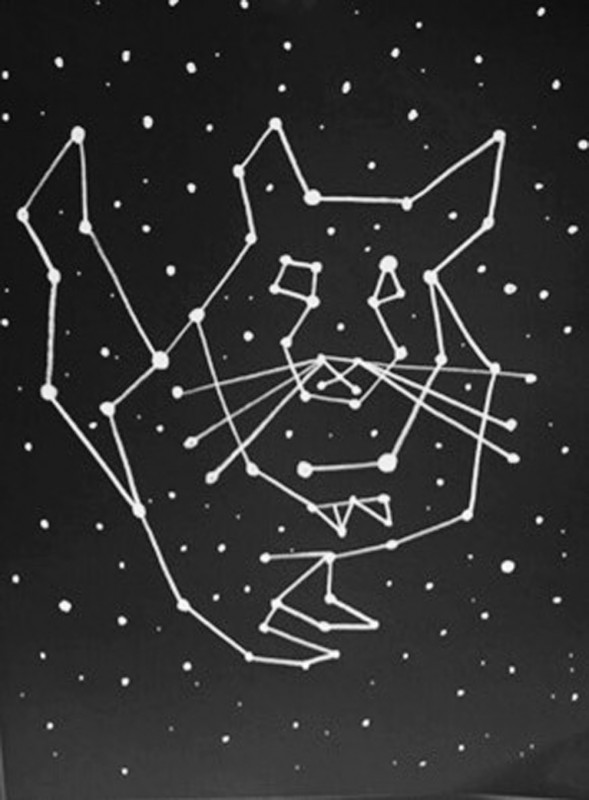
Constellations, for example, are powerful examples of endless possibility. People looking up into the sky and connecting the dots according to their own inclinations. They are also, like so much religion and superstition, exemplars of a human’s urge—or need—to find meaning and design amid the chaos. We look up to the sky and see stories and gods in stars and clouds, we look down at the lines in our palms, into the grounds left at the bottom of our coffee cups, for signs about our futures. A lot of it seems to be projecting meaning more so than finding it.
My father majored in religion in college—a fact that always stumps me when I recall it. The man I knew him to be wasn’t remotely religious, or even particularly interested in religion in an intellectual sense. Obviously he must’ve been back then, when he chose to devote his formative and expensive educational years to its study, but clearly it had lost its grip on him by the time my sister and I tumbled onto the scene. He was more against organized religion than he was interested in it. He did still like types of mythology though. Strange and magical stories exploring realms of the spirit, the kind of bizarre and beautiful folklore that is aware of its own invention, not passing itself off as something other than a human conjuring, not claiming to be anything like absolute truth. He was interested in larger meanings, my father, but he found them in art and play and creativity. My guess is that earlier on he was drawn in by the aesthetics of religion—the narratives and rituals, the sacred spaces.
Athena, remember, is a pseudonym. I could’ve chosen to call her any name I wanted, but I chose Athena, the Greek goddess of wisdom, inspiration, and among other things, crafts. My Athena is both wise and inspiring, but she is also the host of a crafting club that meets in her apartment every other Thursday night. I’ve never been invited to join this club, despite once dropping a perhaps heavy-handed hint about how much I loved making elaborate paper airplanes as a kid and missed that feeling of getting lost in the details of physical artistic construction. I wonder if I may have described my childhood enthusiasm a bit too enthusiastically.
Slide #4:
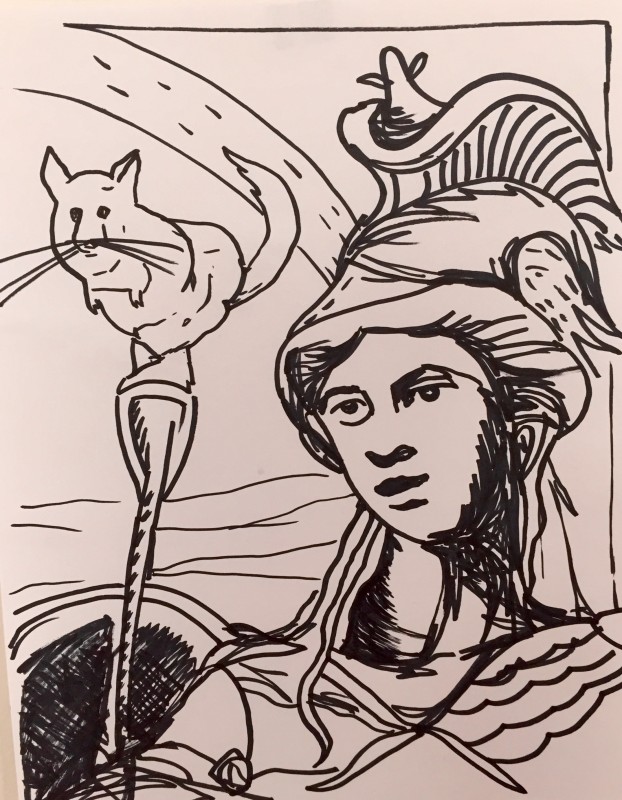
I’m reminded of a living statue I sometimes see in Washington Square Park—a woman who wears a white toga and paints her skin all white and coats her hair in some smooth, thick white substance and holds statuesque poses for very long periods of time. She is not, though, one of those living statues that moves upon donation, or like “The Silver Cowboy,” who startles people by suddenly drawing his silver revolver when someone comes close to inspect his stillness. The toga woman does not move. Her performance is her stillness, and that alone. If you blur your eyes a little, she becomes marble. She is one with stone.
There is another stone goddess at Washington Square Park, on the arch, which was erected for the 100th anniversary of George Washington’s election as the first president of the United States of America. She perches behind Washington himself, one of two figures framing him standing full height in his commander’s military get-up—a heavy cloak, a sword poised tip-down in front of him, one of those old broad-brimmed hats that buttoned up above the forehead to form squarish wings on either side. I don’t know who she really is, but she could well be Athena. She holds a leafy frond at her front, and from behind, as if strapped to her back, rises a kind of horn, not dissimilar to a football fan’s vuvuzela. Perhaps she is the goddess of the battle cry.
Legend has it that Washington had a set of false teeth made from wood. In some versions he carved them himself, and in some particularly fantastical tales he fashions them from a chunk of aged wood from his father’s cherry tree, the one he supposedly hatcheted as a young lad in a moment of mischievous bad conscience but later confessed to and repented for with the famous precociously moral statement, “I cannot tell a lie.” Of course, like every legend, it’s all a load of wonderful bullshit, invented by Washington’s first popular biographer, an itinerant priest and bookseller named Mason Locke Weems. But before knowing all this, I knew, true or not, that George Washington had wooden teeth. And I wondered: how would the wood not rot? Who on earth would think that wood was a reasonable material choice for dentures? The mouth is constant moisture…
But it’s a fascinating concept: the way we embed non-living materials into our bodies. Athena has titanium in one of her lungs. It collapsed when she was 16, one Sunday while she was sitting in church with her parents. It was a moment of prayer, everyone with their heads down, and suddenly she was gasping for air. The first surgery failed, the second had “complications.” It was two days before she felt confident she’d survive it. Now she has bits of titanium holding out the structure of her lung. She doesn’t go to church anymore.
Once I dreamt I was a doctor, examining x-rays of her chest.
Slide #5:
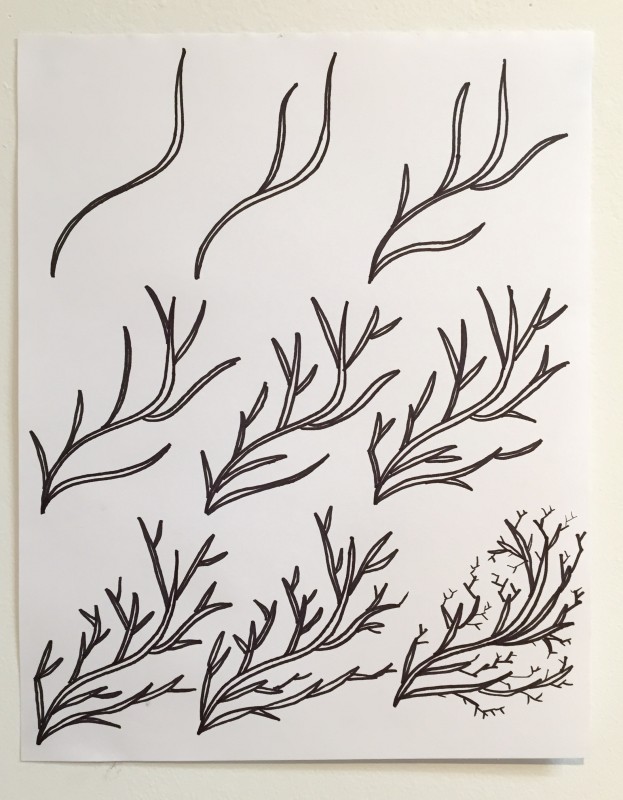
You will remember from some early science class that the human lungs have a system of branching air passages—the bronchi and bronchioles, which together with the trachea and larynx form “the bronchial tree.” Since it points downward though, it more resembles a tree’s root system. In my dream, on Athena’s x-rays, I could see the system growing, new root branches forming, building out the organic structure of her lung behind the glowing pieces of titanium. It was like it was healing itself. Or maybe like I was healing it, with my will, with my desire to do something for her.
Here’s a story I’ve never told anyone.
The night that Athena’s first chinchilla died, as I already mentioned, I encountered her in the stairwell. It was clear she’d been crying, so I asked her if she was okay.
She looked me in the eyes and said, “Maria died.”
For a moment I was disoriented. I thought Maria might be her sister, who she’d once told me about, or the old woman who lived on the ground floor and never spoke to anybody. I gasped. Then I remembered that Maria was her chinchilla’s name. Not that losing a pet can’t be just as devastating as losing a person.
“Oh no,” I said, “that’s so sad.”
I put my hand on the side of her upper arm and left it there.
“He seemed fine when I left this morning,” she said. “Now he’s just dead.”
Again I was momentarily confused. “I’m so sorry,” I said. “Maria was a male?”
She nodded solemnly. “His full name was Rainer Maria.”
I had to smile—it was too good.
“You named your chinchilla after Rilke?”
She snuffled a laugh and nodded again.
“That’s terrific,” I said.
She looked at me and really laughed this time, fresh tears rolling down her smiling cheeks. I laughed too, and squeezed her arm a little.
“It’s so ridiculous,” she said.
“Yes,” I said, “in a terrific way.”
We laughed even harder for a few seconds, then the laugh waned. I asked if there was anything I could do to help. She seemed to have a sobering thought.
“I don’t know what to do with his body. There’s nowhere to bury him. Everything here is concrete! I can’t just throw him in the trash!”
I know what most American men would do in this situation. They’d offer to just make Maria’s body go away, no questions asked. Then they’d take the body and put it in a bag and throw it in the trash and say something like, “he’s in a better place now,” or “that wasn’t him in there, it was just a body. Don’t even think about it.” But I knew better than to do that. My father did that to me once with a cat we had when I was a kid. While I was at school he took the cat’s body and buried it in the woods. He told me when I got home, probably thinking I’d be relieved, but I was so angry that I hadn’t been able to participate in the burial. I was crushed that I hadn’t been there to say goodbye.
“We’ll bury him,” I said to Athena, still holding her arm. “In the park.”
She paused on the thought, bewildered and beautiful.
Slide #6:
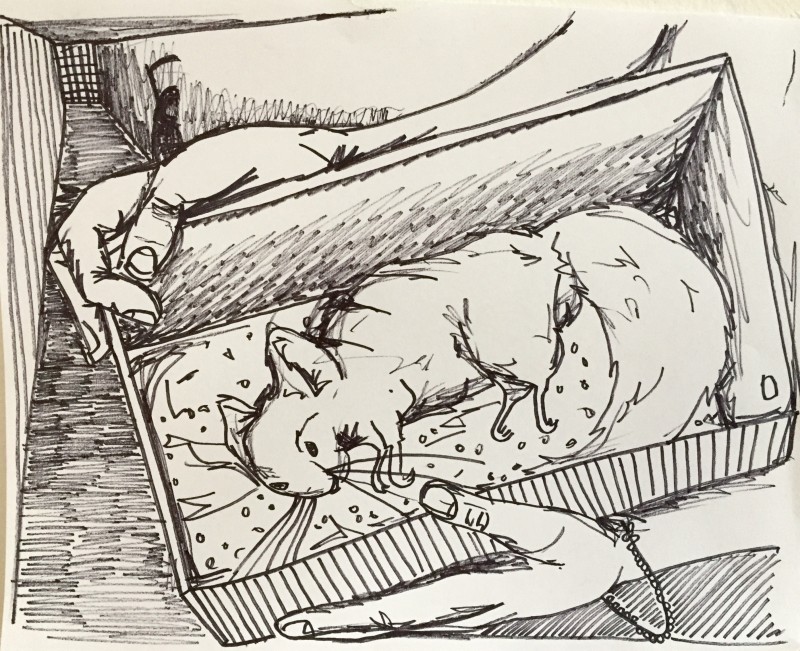
We put Maria in a shoebox. Athena did it with her bare hands. I held him for a moment while she took the top off the box. His body had been so hyper-tense when he was alive, but dead it was as soft and limp as anything you’ve ever held. A living body holds itself up against gravity. A dead body does nothing. The softness of his fur on his dead body was otherworldly. After I passed him back to Athena I felt a fine dust on my hands.
We walked down to the park at the end of the next block, which is right on the river. The sun was lowering behind the city and the sky throbbed orange against the skyline, striated with red-edged cirrus clouds. There were a few people around, all of them looking toward the city, some of them looking at it through the cameras on their phones. The park is mostly open, but there is one shrubby area with a dirt path. Athena pointed to a spot under the overhang of a large, unruly bush and said, “there.” I nodded and we both crouched down and began digging with our hands. Athena laid Rainer Maria’s body down into the hole and cried for a bit. I looked at the dirt under her fingernails and wondered what she was thinking about. It seemed like she was crying for more than him.
We covered his body with the earth we’d dug up, and with our silent goodbyes. We walked wordlessly toward the river. We sat down on a rock and looked across the water to the vivid, living, livid city. I turned to her and saw the face of a goddess, streaked by tears and meaning. She turned to meet my eyes and I was overcome with purpose—I don’t know how else to put it. I leaned in to kiss her.
But she turned away.
That’s the story I’ve never told anyone.
Rilke once wrote:
No matter how deeply I go into myself
my God is dark, and like a webbing made
of a hundred roots that drink in silence
But there is no number of roots. They forever grow and fork.
My father is me.
Stillness was the dead chinchilla’s performance.
It doesn’t make a difference whether George Washington’s teeth were wood or not.
Everything is matter.
Everything matters.
Slide #7:
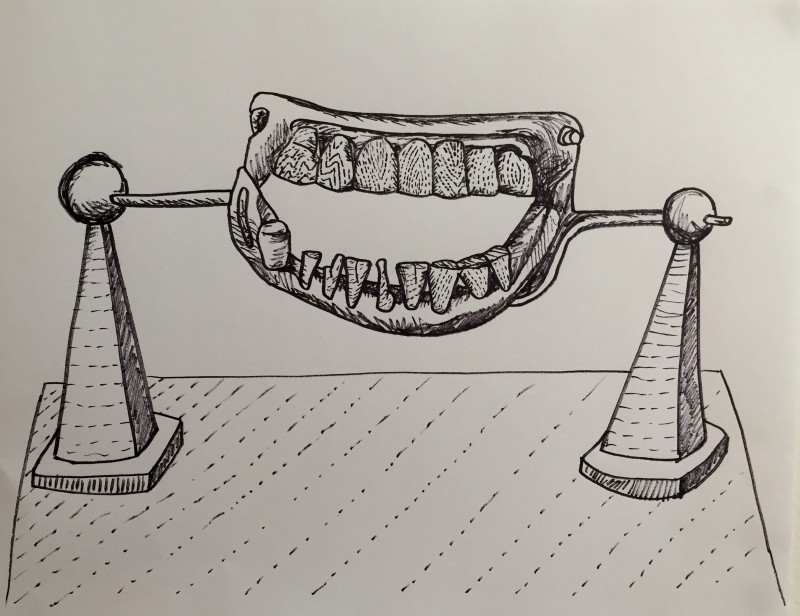
Sam Beebe lives in Brooklyn and teaches writing at New York University. He is currently at work on a non-fiction book which investigates the mysterious, unnatural death of his grandmother.
Christopher Dunlap is a painter living and working in Brooklyn, New York. He holds a BFA in painting from the University of Washington and an MFA in studio arts from Massachusetts College of Art.